10.7: Trigonometric Equations and Inequalities
( \newcommand{\kernel}{\mathrm{null}\,}\)
In Sections 10.2, 10.3 and most recently 10.6, we solved some basic equations involving the trigonometric functions. Below we summarize the techniques we’ve employed thus far. Note that we use the neutral letter ‘u’ as the argument1 of each circular function for generality.
Strategies for Solving Basic Equations Involving Trigonometric Functions
- To solve cos(u)=c or sin(u)=c for −1≤c≤1, first solve for u in the interval [0,2π) and add integer multiples of the period 2π. If c<−1 or of c>1, there are no real solutions.
- To solve sec(u)=c or csc(u)=c for c≤−1 or c≥1, convert to cosine or sine, respectively, and solve as above. If −1<c<1, there are no real solutions.
- To solve tan(u)=c for any real number c, first solve for u in the interval (−π2,π2) and add integer multiples of the period π.
- To solve cot(u)=c for c≠0, convert to tangent and solve as above. If c=0, the solution to cot(u)=0 is u=π2+πk for integers k.
Using the above guidelines, we can comfortably solve sin(x)=12 and find the solution x=π6+2πk or x=5π6+2πk for integers k. How do we solve something like sin(3x)=12? Since this equation has the form sin(u)=12, we know the solutions take the form u=π6+2πk or u=5π6+2πk for integers k. Since the argument of sine here is 3x, we have 3x=π6+2πk or 3x=5π6+2πk for integers k. To solve for x, we divide both sides2 of these equations by 3, and obtain x=π18+2π3k or x=5π18+2π3k for integers k. This is the technique employed in the example below.
Solve the following equations and check your answers analytically. List the solutions which lie in the interval [0,2π) and verify them using a graphing utility.
- cos(2x)=−√32
- csc(13x−π)=√2
- cot(3x)=0
- sec2(x)=4
- tan(x2)=−3
- sin(2x)=0.87
Solution
- The solutions to cos(u)=−√32 are u=5π6+2πk or u=7π6+2πk for integers k. Since the argument of cosine here is 2x, this means 2x=5π6+2πk or 2x=7π6+2πk for integers k. Solving for x gives x=5π12+πk or x=7π12+πk for integers k. To check these answers analytically, we substitute them into the original equation. For any integer k we have
cos(2[5π12+πk])=cos(5π6+2πk)=cos(5π6)(the period of cosine is 2π)=−√32
Similarly, we find cos(2[7π12+πk])=cos(7π6+2πk)=cos(7π6)=−√32. To determine which of our solutions lie in [0,2π), we substitute integer values for k. The solutions we keep come from the values of k=0 and k=1 and are x=5π12, 7π12, 17π12 and 19π12. Using a calculator, we graph y=cos(2x) and y=−√32 over [0,2π) and examine where these two graphs intersect. We see that the x-coordinates of the intersection points correspond to the decimal representations of our exact answers.
- Since this equation has the form csc(u)=√2, we rewrite this as sin(u)=√22 and find u=π4+2πk or u=3π4+2πk for integers k. Since the argument of cosecant here is (13x−π),
13x−π=π4+2πkor13x−π=3π4+2πk
To solve 13x−π=π4+2πk, we first add π to both sides
13x=π4+2πk+π
A common error is to treat the ‘2πk’ and ‘π’ terms as ‘like’ terms and try to combine them when they are not.3 We can, however, combine the ‘π’ and ‘π4’ terms to get
13x=5π4+2πk
We now finish by multiplying both sides by 3 to get
x=3(5π4+2πk)=15π4+6πk
Solving the other equation, 13x−π=3π4+2πk produces x=21π4+6πk for integers k. To check the first family of answers, we substitute, combine line terms, and simplify.
csc(13[15π4+6πk]−π)=csc(5π4+2πk−π)=csc(π4+2πk)=csc(π4)(the period of cosecant is 2π)=√2
The family x=21π4+6πk checks similarly. Despite having infinitely many solutions, we find that none of them lie in [0,2π). To verify this graphically, we use a reciprocal identity to rewrite the cosecant as a sine and we find that y=1sin(13x−π) and y=√2 do not intersect at all over the interval [0,2π).
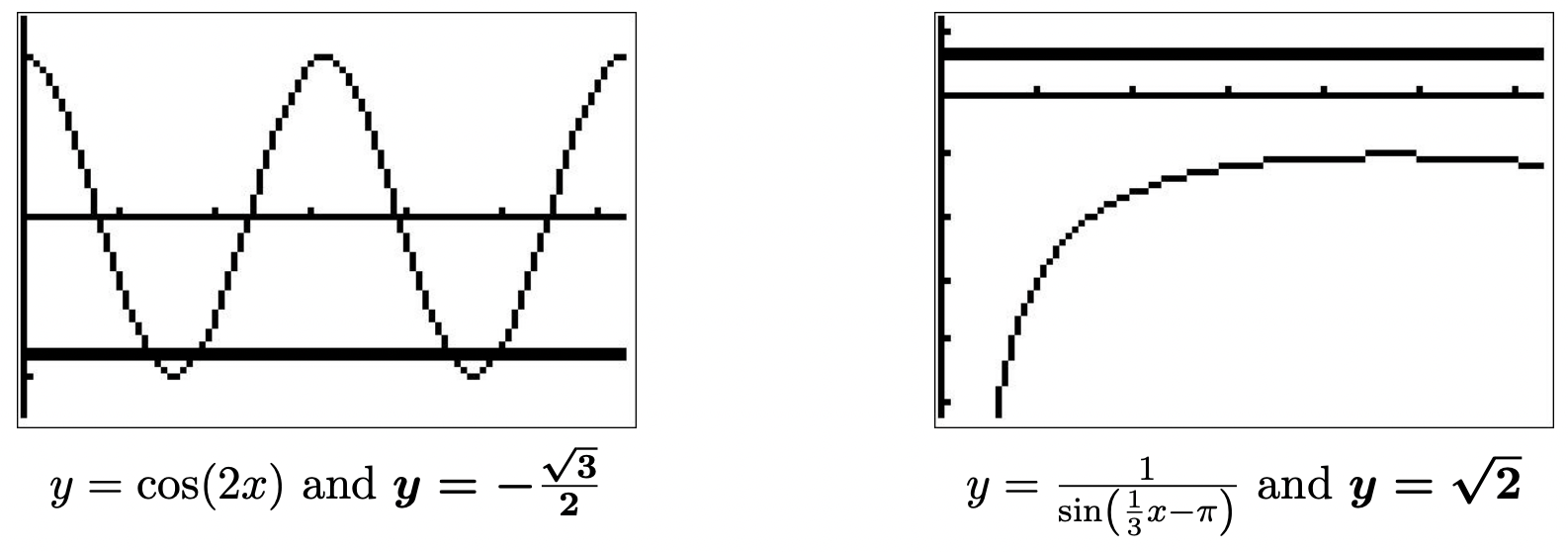
- Since cot(3x)=0 has the form cot(u)=0, we know u=π2+πk, so, in this case, 3x=π2+πk for integers k. Solving for x yields x=π6+π3k. Checking our answers, we get
cot(3[π6+π3k])=cot(π2+πk)=cot(π2)(the period of cotangent is π)=0
As k runs through the integers, we obtain six answers, corresponding to k=0 through k=5, which lie in [0,2π): x=π6, π2, 5π6, 7π6, 3π2 and 11π6. To confirm these graphically, we must be careful. On many calculators, there is no function button for cotangent. We choose4 to use the quotient identity cot(3x)=cos(3x)sin(3x). Graphing y=cos(3x)sin(3x) and y=0 (the x-axis), we see that the x-coordinates of the intersection points approximately match our solutions.
- The complication in solving an equation like sec2(x)=4 comes not from the argument of secant, which is just x, but rather, the fact the secant is being squared. To get this equation to look like one of the forms listed on page 857, we extract square roots to get sec(x)=±2. Converting to cosines, we have cos(x)=±12. For cos(x)=12, we get x=π3+2πk or x=5π3+2πk for integers k. For cos(x)=−12, we get x=2π3+2πk or x=4π3+2πk for integers k. If we take a step back and think of these families of solutions geometrically, we see we are finding the measures of all angles with a reference angle of π3. As a result, these solutions can be combined and we may write our solutions as x=π3+πk and x=2π3+πk for integers k. To check the first family of solutions, we note that, depending on the integer k, sec(π3+πk) doesn’t always equal sec(π3). However, it is true that for all integers k, sec(π3+πk)=±sec(π3)=±2. (Can you show this?) As a result,
sec2(π3+πk)=(±sec(π3))2=(±2)2=4
The same holds for the family x=2π3+πk. The solutions which lie in [0,2π) come from the values k=0 and k=1, namely x=π3, 2π3, 4π3 and 5π3. To confirm graphically, we use a reciprocal identity to rewrite the secant as cosine. The x-coordinates of the intersection points of y=1(cos(x))2 and y=4 verify our answers.
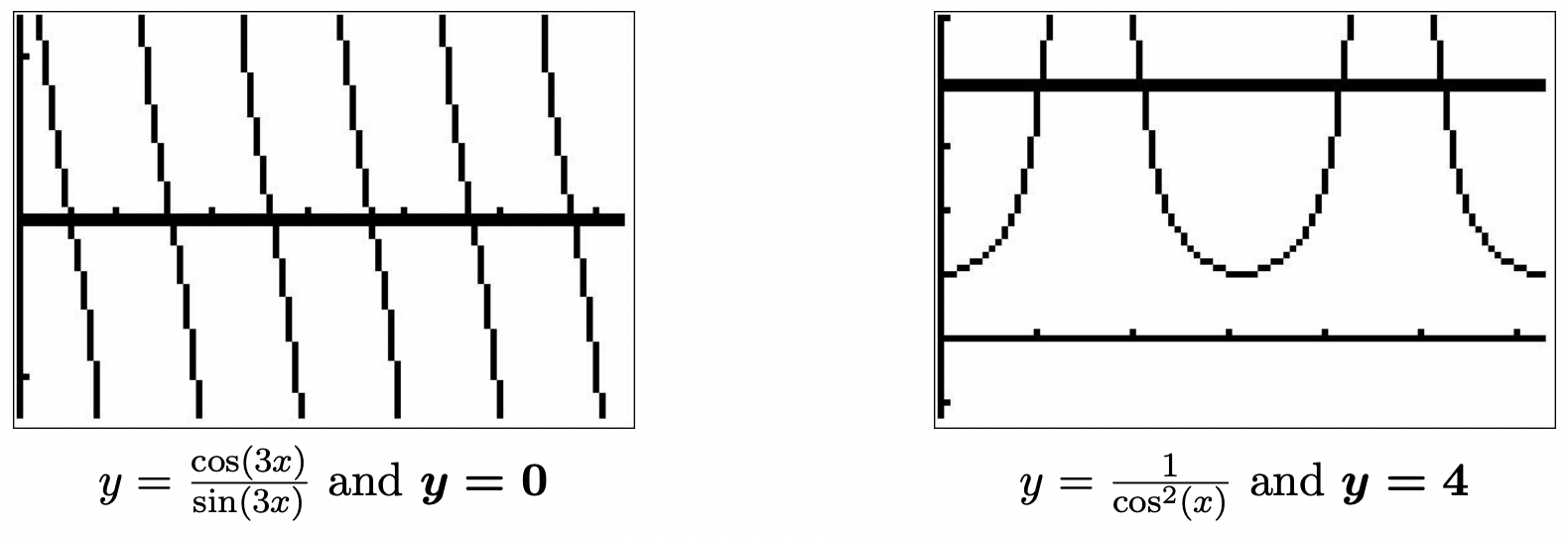
- The equation tan(x2)=−3 has the form tan(u)=−3, whose solution is u=arctan(−3)+πk. Hence, x2=arctan(−3)+πk, so x=2arctan(−3)+2πk for integers k. To check, we note
tan(2arctan(−3)+2πk2)=tan(arctan(−3)+πk)=tan(arctan(−3))(the period of tangent is π)=−3(See Theorem 10.27)
To determine which of our answers lie in the interval [0,2π), we first need to get an idea of the value of 2arctan(−3). While we could easily find an approximation using a calculator,5 we proceed analytically. Since −3<0, it follows that −π2<arctan(−3)<0. Multiplying through by 2 gives −π<2arctan(−3)<0. We are now in a position to argue which of the solutions x=2arctan(−3)+2πk lie in [0,2π). For k=0, we get x=2arctan(−3)<0, so we discard this answer and all answers x=2arctan(−3)+2πk where k<0. Next, we turn our attention to k=1 and get x=2arctan(−3)+2π. Starting with the inequality −π<2arctan(−3)<0, we add 2π and get π<2arctan(−3)+2π<2π. This means x=2arctan(−3)+2π lies in [0,2π). Advancing k to 2 produces x=2arctan(−3)+4π. Once again, we get from −π<2arctan(−3)<0 that 3π<2arctan(−3)+4π<4π. Since this is outside the interval [0,2π), we discard x=2arctan(−3)+4π and all solutions of the form x=2arctan(−3)+2πk for k>2. Graphically, we see y=tan(x2) and y=−3 intersect only once on [0,2π) at x=2arctan(−3)+2π≈3.7851.
- To solve sin(2x)=0.87, we first note that it has the form sin(u)=0.87, which has the family of solutions u=arcsin(0.87)+2πk or u=π−arcsin(0.87)+2πk for integers k. Since the argument of sine here is 2x, we get 2x=arcsin(0.87)+2πk or 2x=π−arcsin(0.87)+2πk which gives x=12arcsin(0.87)+πk or x=π2−12arcsin(0.87)+πk for integers k. To check,
sin(2[12arcsin(0.87)+πk])=sin(arcsin(0.87)+2πk)=sin(arcsin(0.87))(the period of sine is 2π)=0.87(See Theorem 10.26)
For the family x=π2−12arcsin(0.87)+πk, we get
sin(2[π2−12arcsin(0.87)+πk])=sin(π−arcsin(0.87)+2πk)=sin(π−arcsin(0.87))(the period of sine is 2π)=sin(arcsin(0.87))(sin(π−t)=sin(t))=0.87(See Theorem 10.26)
To determine which of these solutions lie in [0,2π), we first need to get an idea of the value of x=12arcsin(0.87). Once again, we could use the calculator, but we adopt an analytic route here. By definition, 0<arcsin(0.87)<π2 so that multiplying through by 12 gives us 0<12arcsin(0.87)<π4. Starting with the family of solutions x=12arcsin(0.87)+πk, we use the same kind of arguments as in our solution to number 5 above and find only the solutions corresponding to k=0 and k=1 lie in [0,2π): x=12arcsin(0.87) and x=12arcsin(0.87)+π. Next, we move to the family x=π2−12arcsin(0.87)+πk for integers k. Here, we need to get a better estimate of π2−12arcsin(0.87). From the inequality 0<12arcsin(0.87)<π4, we first multiply through by −1 and then add π2 to get π2>π2−12arcsin(0.87)>π4, or π4<π2−12arcsin(0.87)<π2. Proceeding with the usual arguments, we find the only solutions which lie in [0,2π) correspond to k=0 and k=1, namely x=π2−12arcsin(0.87) and x=3π2−12arcsin(0.87). All told, we have found four solutions to sin(2x)=0.87 in [0,2π): x=12arcsin(0.87), x=12arcsin(0.87)+π, x=π2−12arcsin(0.87) and x=3π2−12arcsin(0.87). By graphing y=sin(2x) and y=0.87, we confirm our results.
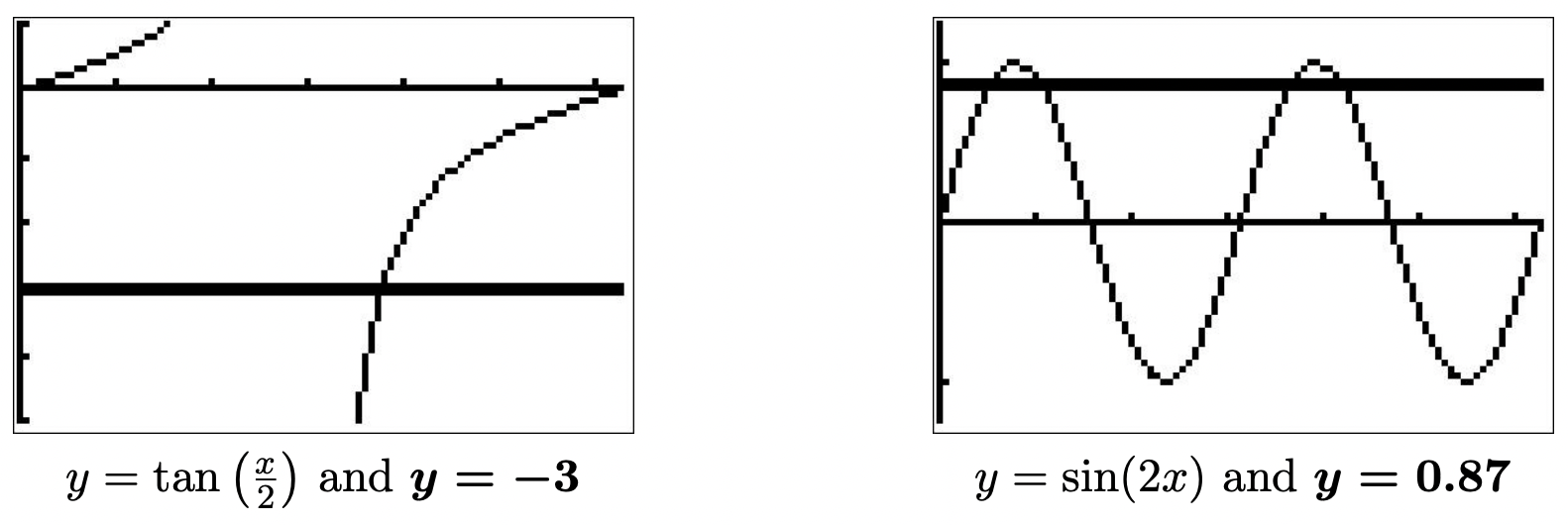
Each of the problems in Example 10.7.1 featured one trigonometric function. If an equation involves two different trigonometric functions or if the equation contains the same trigonometric function but with different arguments, we will need to use identities and Algebra to reduce the equation to the same form as those given on page 857.
Solve the following equations and list the solutions which lie in the interval [0,2π). Verify your solutions on [0,2π) graphically.
- 3sin3(x)=sin2(x)
- sec2(x)=tan(x)+3
- cos(2x)=3cos(x)−2
- cos(3x)=2−cos(x)
- cos(3x)=cos(5x)
- sin(2x)=√3cos(x)
- sin(x)cos(x2)+cos(x)sin(x2)=1
- cos(x)−√3sin(x)=2
Solution.
- We resist the temptation to divide both sides of 3sin3(x)=sin2(x) by sin2(x) (What goes wrong if you do?) and instead gather all of the terms to one side of the equation and factor.
3sin3(x)=sin2(x)3sin3(x)−sin2(x)=0sin2(x)(3sin(x)−1)=0Factor out sin2(x) from both terms.
We get sin2(x)=0 or 3sin(x)−1=0. Solving for sin(x), we find sin(x)=0 or sin(x)=13. The solution to the first equation is x=πk, with x=0 and x=π being the two solutions which lie in [0,2π). To solve sin(x)=13, we use the arcsine function to get x=arcsin(13)+2πk or x=π−arcsin(13)+2πk for integers k. We find the two solutions here which lie in [0,2π) to be x=arcsin(13) and x=π−arcsin(13). To check graphically, we plot y=3(sin(x))3 and y=(sin(x))2 and find the x-coordinates of the intersection points of these two curves. Some extra zooming is required near x=0 and x=π to verify that these two curves do in fact intersect four times.6
- Analysis of sec2(x)=tan(x)+3 reveals two different trigonometric functions, so an identity is in order. Since sec2(x)=1+tan2(x), we get
sec2(x)=tan(x)+31+tan2(x)=tan(x)+3(Since sec2(x)=1+tan2(x).)tan2(x)−tan(x)−2=0u2−u−2=0Let u=tan(x).(u+1)(u−2)=0
This gives u=−1 or u=2. Since u=tan(x), we have tan(x)=−1 or tan(x)=2. From tan(x)=−1, we get x=−π4+πk for integers k. To solve tan(x)=2, we employ the arctangent function and get x=arctan(2)+πk for integers k. From the first set of solutions, we get x=3π4 and x=5π4 as our answers which lie in [0,2π). Using the same sort of argument we saw in Example 10.7.1, we get x=arctan(2) and x=π+arctan(2) as answers from our second set of solutions which lie in [0,2π). Using a reciprocal identity, we rewrite the secant as a cosine and graph y=1(cos(x))2 and y=tan(x)+3 to find the x-values of the points where they intersect.

- In the equation cos(2x)=3cos(x)−2, we have the same circular function, namely cosine, on both sides but the arguments differ. Using the identity cos(2x)=2cos2(x)−1, we obtain a ‘quadratic in disguise’ and proceed as we have done in the past.
cos(2x)=3cos(x)−22cos2(x)−1=3cos(x)−2(Since cos(2x)=2cos2(x)−1.)2cos2(x)−3cos(x)+1=02u2−3u+1=0Let u=cos(x).(2u−1)(u−1)=0
This gives u=12 or u=1. Since u=cos(x), we get cos(x)=12 or cos(x)=1. Solving cos(x)=12, we get x=π3+2πk or x=5π3+2πk for integers k. From cos(x)=1, we get x=2πk for integers k. The answers which lie in [0,2π) are x=0, π3, and 5π3. Graphing y=cos(2x) and y=3cos(x)−2, we find, after a little extra effort, that the curves intersect in three places on [0,2π), and the x-coordinates of these points confirm our results.
- To solve cos(3x)=2−cos(x), we use the same technique as in the previous problem. From Example 10.4.3, number 4, we know that cos(3x)=4cos3(x)−3cos(x). This transforms the equation into a polynomial in terms of cos(x).
cos(3x)=2−cos(x)4cos3(x)−3cos(x)=2−cos(x)2cos3(x)−2cos(x)−2=04u3−2u−2=0Let u=cos(x).
To solve 4u3−2u−2=0, we need the techniques in Chapter 3 to factor 4u3−2u−2 into (u−1)(4u2+4u+2). We get either u−1=0 or 4u2+2u+2=0, and since the discriminant of the latter is negative, the only real solution to 4u3−2u−2=0 is u=1. Since u=cos(x), we get cos(x)=1, so x=2πk for integers k. The only solution which lies in [0,2π) is x=0. Graphing y=cos(3x) and y=2−cos(x) on the same set of axes over [0,2π) shows that the graphs intersect at what appears to be (0,1), as required.

- While we could approach cos(3x)=cos(5x) in the same manner as we did the previous two problems, we choose instead to showcase the utility of the Sum to Product Identities. From cos(3x)=cos(5x), we get cos(5x)−cos(3x)=0, and it is the presence of 0 on the right hand side that indicates a switch to a product would be a good move.7 Using Theorem 10.21, we have that cos(5x)−cos(3x)=−2sin(5x+3x2)sin(5x−3x2)=−2sin(4x)sin(x). Hence, the equation cos(5x)=cos(3x) is equivalent to −2sin(4x)sin(x)=0. From this, we get sin(4x)=0 or sin(x) = 0. Solving sin(4x)=0 gives x=π4k for integers k, and the solution to sin(x)=0 is x=πk for integers k. The second set of solutions is contained in the first set of solutions,8 so our final solution to cos(5x)=cos(3x) is x=π4k for integers k. There are eight of these answers which lie in [0,2π): x=0, π4, π2, 3π4, π, 5π4, 3π2 and 7π4. Our plot of the graphs of y=cos(3x) and y=cos(5x) below (after some careful zooming) bears this out.
- In examining the equation sin(2x)=√3cos(x), not only do we have different circular functions involved, namely sine and cosine, we also have different arguments to contend with, namely 2x and x. Using the identity sin(2x)=2sin(x)cos(x) makes all of the arguments the same and we proceed as we would solving any nonlinear equation – gather all of the nonzero terms on one side of the equation and factor.
sin(2x)=√3cos(x)2sin(x)cos(x)=√3cos(x)(Since sin(2x)=2sin(x)cos(x).)2sin(x)cos(x)−√3cos(x)=0cos(x)(2sin(x)−√3)=0
from which we get cos(x)=0 or sin(x)=√32. From cos(x)=0, we obtain x=π2+πk for integers k. From sin(x)=√32, we get x=π3+2πk or x=2π3+2πk for integers k. The answers which lie in [0,2π) are x=π2, 3π2, π3 and 2π3. We graph y=sin(2x) and y=√3cos(x) and, after some careful zooming, verify our answers.

- Unlike the previous problem, there seems to be no quick way to get the circular functions or their arguments to match in the equation sin(x)cos(x2)+cos(x)sin(x2)=1. If we stare at it long enough, however, we realize that the left hand side is the expanded form of the sum formula for sin(x+x2). Hence, our original equation is equivalent to sin(32x)=1. Solving, we find x=π3+4π3k for integers k. Two of these solutions lie in [0,2π): x=π3 and x=5π3. Graphing y=sin(x)cos(x2)+cos(x)sin(x2) and y=1 validates our solutions.
- With the absence of double angles or squares, there doesn’t seem to be much we can do. However, since the arguments of the cosine and sine are the same, we can rewrite the left hand side of this equation as a sinusoid.9 To fit f(x)=cos(x)−√3sin(x) to the form Asin(ωt+ϕ)+B, we use what we learned in Example 10.5.3 and find A=2, B=0, ω=1 and ϕ=5π6. Hence, we can rewrite the equation cos(x)−√3sin(x)=2 as 2sin(x+5π6)=2, or sin(x+5π6)=1. Solving the latter, we get x=−π3+2πk for integers k. Only one of these solutions, x=5π3, which corresponds to k=1, lies in [0,2π). Geometrically, we see that y=cos(x)−√3sin(x) and y=2 intersect just once, supporting our answer.

We repeat here the advice given when solving systems of nonlinear equations in section 8.7 – when it comes to solving equations involving the trigonometric functions, it helps to just try something.
Next, we focus on solving inequalities involving the trigonometric functions. Since these functions are continuous on their domains, we may use the sign diagram technique we’ve used in the past to solve the inequalities.10
Solve the following inequalities on [0,2π). Express your answers using interval notation and verify your answers graphically.
- 2sin(x)≤1
- sin(2x)>cos(x)
- tan(x)≥3
Solution
- We begin solving 2sin(x)≤1 by collecting all of the terms on one side of the equation and zero on the other to get 2sin(x)−1≤0. Next, we let f(x)=2sin(x)−1 and note that our original inequality is equivalent to solving f(x)≤0. We now look to see where, if ever, f is undefined and where f(x)=0. Since the domain of f is all real numbers, we can immediately set about finding the zeros of f. Solving f(x)=0, we have 2sin(x)−1=0 or sin(x)=12. The solutions here are x=π6+2πk and x=5π6+2πk for integers k. Since we are restricting our attention to [0,2π), only x=π6 and x=5π6 are of concern to us. Next, we choose test values in [0,2π) other than the zeros and determine if f is positive or negative there. For x=0 we have f(0)=−1, for x=π2 we get f(π2)=1 and for x=π we get f(π)=−1. Since our original inequality is equivalent to f(x)≤0, we are looking for where the function is negative (−) or 0, and we get the intervals [0,π6]∪[5π6,2π). We can confirm our answer graphically by seeing where the graph of y=2sin(x) crosses or is below the graph of y=1.
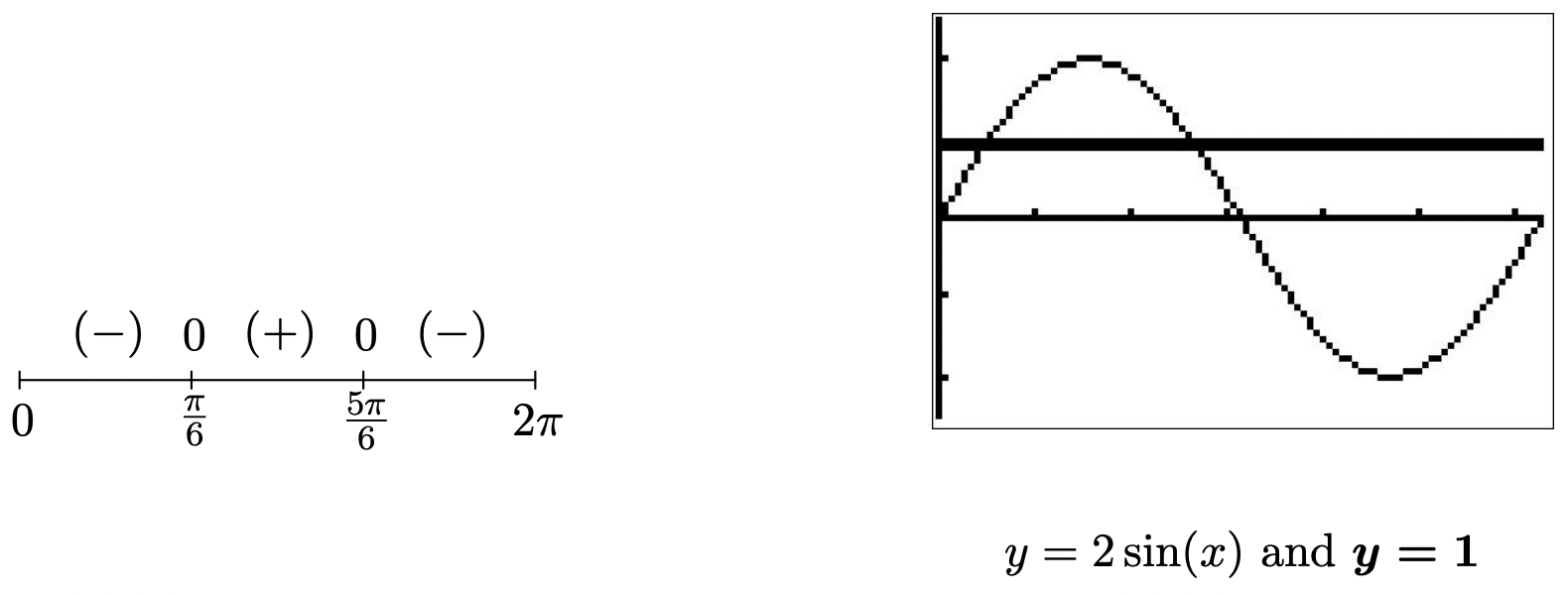
- We first rewrite sin(2x)>cos(x) as sin(2x)−cos(x)>0 and let f(x)=sin(2x)−cos(x). Our original inequality is thus equivalent to f(x)>0. The domain of f is all real numbers, so we can advance to finding the zeros of f. Setting f(x)=0 yields sin(2x)−cos(x)=0, which, by way of the double angle identity for sine, becomes 2sin(x)cos(x)−cos(x)=0 or cos(x)(2sin(x)−1)=0. From cos(x)=0, we get x=π2+πk for integers k of which only x=π2 and x=3π2 lie in [0,2π). For 2sin(x)−1=0, we get sin(x)=12 which gives x=π6+2πk or x=5π6+2πk for integers k. Of those, only x=π6 and x=5π6 lie in [0,2π). Next, we choose our test values. For x=0 we find f(0)=−1; when x=π4 we get f(π4)=1−√22=2−√22; for x=3π4 we get f(3π4)=−1+√22=√2−22; when x=π we have f(π)=1, and lastly, for x=7π4 we get f(7π4)=−1−√22=−2−√22. We see f(x)>0 on (π6,π2)∪(5π6,3π2), so this is our answer. We can use the calculator to check that the graph of y=sin(2x) is indeed above the graph of y=cos(x) on those intervals.

- Proceeding as in the last two problems, we rewrite tan(x)≥3 as tan(x)−3≥0 and let f(x)=tan(x)−3. We note that on [0,2π), f is undefined at x=π2 and 3π2, so those values will need the usual disclaimer on the sign diagram.11 Moving along to zeros, solving f(x)=tan(x)−3=0 requires the arctangent function. We find x=arctan(3)+πk for integers k and of these, only x=arctan(3) and x=arctan(3)+π lie in [0,2π). Since 3>0, we know 0<arctan(3)<π2 which allows us to position these zeros correctly on the sign diagram. To choose test values, we begin with x=0 and find f(0)=−3. Finding a convenient test value in the interval (arctan(3),π2) is a bit more challenging. Keep in mind that the arctangent function is increasing and is bounded above by π2. This means that the number x=arctan(117) is guaranteed12 to lie between arctan(3) and π2. We see that f(arctan(117))=tan(arctan(117))−3=114. For our next test value, we take x=π and find f(π)=−3. To find our next test value, we note that since arctan(3)<arctan(117)<π2, it follows13 that arctan(3)+π<arctan(117)+π<3π2. Evaluating f at x=arctan(117)+π yields f(arctan(117)+π)=tan(arctan(117)+π)−3=tan(arctan(117))−3=114. We choose our last test value to be x=7π4 and find f(7π4)=−4. Since we want f(x)≥0, we see that our answer is [arctan(3),π2)∪[arctan(3)+π,3π2). Using the graphs of y=tan(x) and y=3, we see when the graph of the former is above (or meets) the graph of the latter.
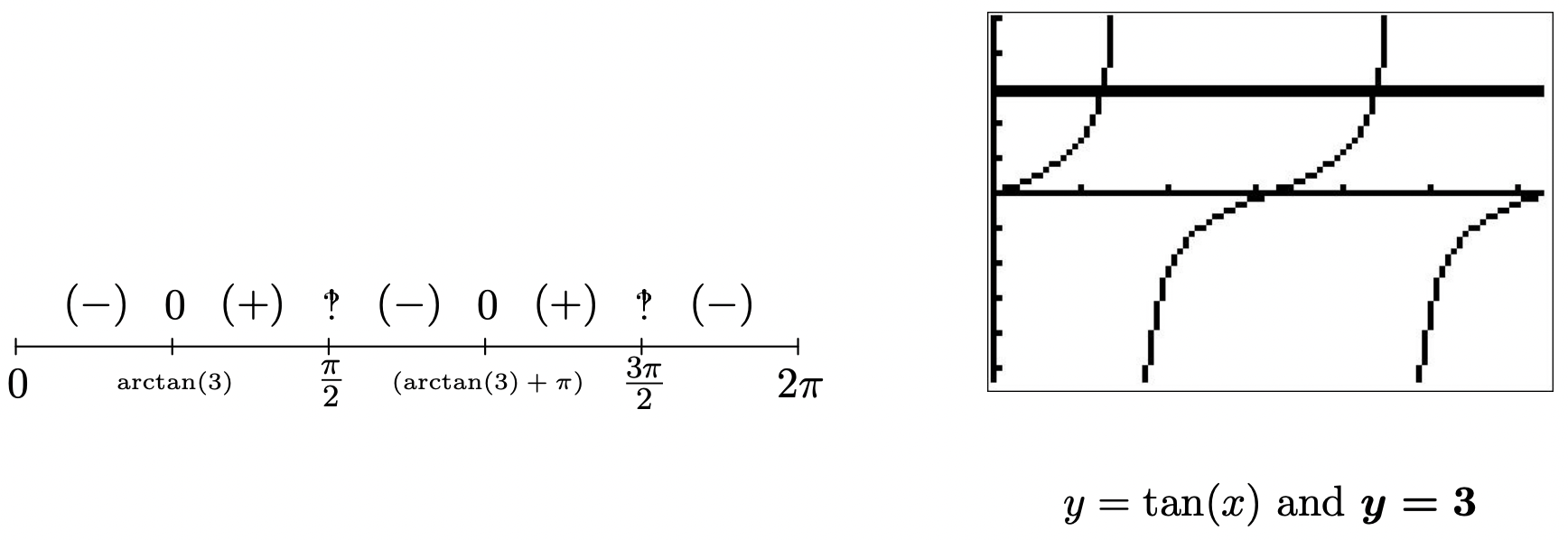
We close this section with an example that puts solving equations and inequalities to good use – finding domains of functions.
Express the domain of the following functions using extended interval notation.14
- f(x)=csc(2x+π3)
- f(x)=sin(x)2cos(x)−1
- f(x)=√1−cot(x)
Solution
- To find the domain of f(x)=csc(2x+π3), we rewrite f in terms of sine as f(x)=1sin(2x+π3). Since the sine function is defined everywhere, our only concern comes from zeros in the denominator. Solving sin(2x+π3)=0, we get x=−π6+π2k for integers k. In set-builder notation, our domain is {x:x≠−π6+π2k for integers k}. To help visualize the domain, we follow the old mantra ‘When in doubt, write it out!’ We get {x:x≠−π6,2π6,−4π6,5π6,−7π6,8π6,…}, where we have kept the denominators 6 throughout to help see the pattern. Graphing the situation on a numberline, we have

Proceeding as we did on page 756 in Section 10.3.1, we let xk denote the kth number excluded from the domain and we have xk=−π6+π2k=(3k−1)π6 for integers k. The intervals which comprise the domain are of the form (xk,xk+1)=((3k−1)π6,(3k+2)π6) as k runs through the integers. Using extended interval notation, we have that the domain is
\bigcup_{k = -\infty}^{\infty} \left(\dfrac{(3k-1)\pi}{6}, \dfrac{(3k+2)\pi}{6} \right)\nonumber
We can check our answer by substituting in values of k to see that it matches our diagram.
- Since the domains of \sin(x) and \cos(x) are all real numbers, the only concern when finding the domain of f(x) = \frac{\sin(x)}{2\cos(x) - 1} is division by zero so we set the denominator equal to zero and solve. From 2\cos(x) - 1 = 0 we get \cos(x) = \frac{1}{2} so that x = \frac{\pi}{3} + 2\pi k or x = \frac{5\pi}{3} + 2\pi k for integers k. Using set-builder notation, the domain is \left\{x: x \neq \frac{\pi}{3}+2 \pi k \text { and } x \neq \frac{5 \pi}{3}+2 \pi k \text { for integers } k\right\}, or \left\{ x : x \neq \pm \frac{\pi}{3}, \pm \frac{5\pi}{3}, \pm \frac{7\pi}{3}, \pm \frac{11\pi}{3}, \ldots \right\}, so we have

Unlike the previous example, we have two different families of points to consider, and we present two ways of dealing with this kind of situation. One way is to generalize what we did in the previous example and use the formulas we found in our domain work to describe the intervals. To that end, we let a_{k} = \frac{\pi}{3} + 2\pi k = \frac{(6k+1)\pi}{3} and b_{k} = \frac{5\pi}{3} + 2\pi k = \frac{(6k+5) \pi}{3} for integers k. The goal now is to write the domain in terms of the a’s an b’s. We find a_0 = \frac{\pi}{3}, a_{1} = \frac{7\pi}{3}, a_{-1} = -\frac{5\pi}{3}, a_{2} = \frac{13\pi}{3}, a_{-2} = -\frac{11\pi}{3}, b_0 = \frac{5\pi}{3}, b_{1} = \frac{11\pi}{3}, b_{-1} = -\frac{\pi}{3}, b_{2} = \frac{17\pi}{3} and b_{-2} = -\frac{7\pi}{3}. Hence, in terms of the a’s and b’s, our domain is
\ldots\left(a_{-2}, b_{-2}\right) \cup\left(b_{-2}, a_{-1}\right) \cup\left(a_{-1}, b_{-1}\right) \cup\left(b_{-1}, a_{0}\right) \cup\left(a_{0}, b_{0}\right) \cup\left(b_{0}, a_{1}\right) \cup\left(a_{1}, b_{1}\right) \cup \ldots\nonumber
If we group these intervals in pairs, \left(a_{-2}, b_{-2} \right) \cup \left(b_{-2}, a_{-1} \right), \left(a_{-1}, b_{-1} \right)\cup \left(b_{-1}, a_0 \right), \left(a_0, b_0 \right)\cup \left(b_0, a_{1} \right) and so forth, we see a pattern emerge of the form \left(a_{k}, b_{k} \right)\cup \left(b_{k}, a_{k+1} \right) for integers k so that our domain can be written as
\bigcup_{k=-\infty}^{\infty}\left(a_{k}, b_{k}\right) \cup\left(b_{k}, a_{k+1}\right)=\bigcup_{k=-\infty}^{\infty}\left(\frac{(6 k+1) \pi}{3}, \frac{(6 k+5) \pi}{3}\right) \cup\left(\frac{(6 k+5) \pi}{3}, \frac{(6 k+7) \pi}{3}\right)\nonumber
A second approach to the problem exploits the periodic nature of f. Since \cos(x) and \sin(x) have period 2\pi, it’s not too difficult to show the function f repeats itself every 2\pi units.15 This means if we can find a formula for the domain on an interval of length 2\pi, we can express the entire domain by translating our answer left and right on the x-axis by adding integer multiples of 2\pi. One such interval that arises from our domain work is \left[\frac{\pi}{3}, \frac{7\pi}{3}\right]. The portion of the domain here is \left(\frac{\pi}{3}, \frac{5\pi}{3}\right) \cup \left(\frac{5\pi}{3}, \frac{7\pi}{3}\right). Adding integer multiples of 2\pi, we get the family of intervals \left(\frac{\pi}{3} + 2\pi k, \frac{5\pi}{3} + 2\pi k \right) \cup \left(\frac{5\pi}{3} + 2\pi k, \frac{7\pi}{3} + 2\pi k\right) for integers k. We leave it to the reader to show that getting common denominators leads to our previous answer.
- To find the domain of f(x) = \sqrt{1-\cot(x)}, we first note that, due to the presence of the \cot(x) term, x \neq \pi k for integers k. Next, we recall that for the square root to be defined, we need 1 - \cot(x) \geq 0. Unlike the inequalities we solved in Example 10.7.3, we are not restricted here to a given interval. Our strategy is to solve this inequality over (0,\pi) (the same interval which generates a fundamental cycle of cotangent) and then add integer multiples of the period, in this case, \pi. We let g(x) = 1 - \cot(x) and set about making a sign diagram for g over the interval (0,\pi) to find where g(x) \geq 0. We note that g is undefined for x = \pi k for integers k, in particular, at the endpoints of our interval x = 0 and x = \pi. Next, we look for the zeros of g. Solving g(x) = 0, we get \cot(x) = 1 or x = \frac{\pi}{4} + \pi k for integers k and only one of these, x = \frac{\pi}{4}, lies in (0,\pi). Choosing the test values x = \frac{\pi}{6} and x = \frac{\pi}{2}, we get g\left(\frac{\pi}{6}\right) = 1 - \sqrt{3}, and g\left(\frac{\pi}{2}\right) = 1.
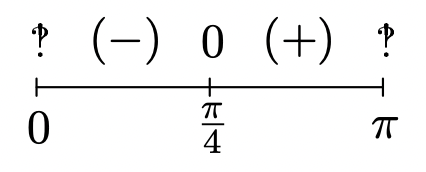
We find g(x) \geq 0 on \left[\frac{\pi}{4}, \pi \right). Adding multiples of the period we get our solution to consist of the intervals \left[\frac{\pi}{4} + \pi k, \pi + \pi k \right) = \left[\frac{(4k+1)\pi}{4}, (k+1)\pi \right). Using extended interval notation, we express our final answer as
\bigcup_{k = -\infty}^{\infty} \left[\dfrac{(4k+1)\pi}{4}, (k+1)\pi \right)\nonumber
We close this section with an example which demonstrates how to solve equations and inequalities involving the inverse trigonometric functions.
Solve the following equations and inequalities analytically. Check your answers using a graphing utility.
- \arcsin (2 x)=\frac{\pi}{3}
- 4 \arccos (x)-3 \pi=0
- 3 \operatorname{arcsec}(2 x-1)+\pi=2 \pi
- 4 \arctan ^{2}(x)-3 \pi \arctan (x)-\pi^{2}=0
- \pi^{2}-4 \arccos ^{2}(x)<0
- 4 \operatorname{arccot}(3 x)>\pi
Solution
- To solve \arcsin (2 x)=\frac{\pi}{3}, we first note that \frac{\pi}{3} is in the range of the arcsine function (so a solution exists!) Next, we exploit the inverse property of sine and arcsine from Theorem 10.26 \begin{aligned} \arcsin (2 x) &=\frac{\pi}{3} \\ \sin (\arcsin (2 x)) &=\sin \left(\frac{\pi}{3}\right) \\ 2 x &=\frac{\sqrt{3}}{2} \quad \text { Since } \sin (\arcsin (u))=u \\ x &=\frac{\sqrt{3}}{4} \end{aligned}\nonumber Graphing y=\arcsin (2 x) and the horizontal line y=\frac{\pi}{3}, we see they intersect at \frac{\sqrt{3}}{4} \approx 0.4430.
- Our first step in solving 4 \arccos (x)-3 \pi=0 is to isolate the arccosine. Doing so, we get \arccos (x)=\frac{3 \pi}{4}. Since \frac{3 \pi}{4} is in the range of arccosine, we may apply Theorem 10.26 \begin{aligned} \arccos (x) &=\frac{3 \pi}{4} \\ \cos (\arccos (x)) &=\cos \left(\frac{3 \pi}{4}\right) \\ x &=-\frac{\sqrt{2}}{2} \quad \text { Since } \cos (\arccos (u))=u \end{aligned}\nonumber The calculator confirms y=4 \arccos (x)-3 \pi crosses y=0 (the x-axis) at -\frac{\sqrt{2}}{2} \approx-0.7071.

- From 3 \operatorname{arcsec}(2 x-1)+\pi=2 \pi, we get \operatorname{arcsec}(2 x-1)=\frac{\pi}{3}. As we saw in Section 10.6, there are two possible ranges for the arcsecant function. Fortunately, both ranges contain \frac{\pi}{3}. Applying Theorem 10.28 / 10.29, we get \begin{aligned} \operatorname{arcsec}(2 x-1) &=\frac{\pi}{3} \\ \sec (\operatorname{arcsec}(2 x-1)) &=\sec \left(\frac{\pi}{3}\right) \\ 2 x-1 &=2 \quad \text { Since } \sec (\operatorname{arcsec}(u))=u \\ x &=\frac{3}{2} \end{aligned}\nonumber To check using our calculator, we need to graph y=3 \operatorname{arcsec}(2 x-1)+\pi. To do so, we make use of the identity \operatorname{arcsec}(u)=\arccos \left(\frac{1}{u}\right) from Theorems 10.28 and 10.29.16 We see the graph of y=3 \arccos \left(\frac{1}{2 x-1}\right)+\pi and the horizontal line y=2 \pi intersect at \frac{3}{2}=1.5.
-
With the presence of both \arctan ^{2}(x)\left(=(\arctan (x))^{2}\right) and \arctan (x), we substitute u=\arctan (x). The equation 4 \arctan ^{2}(x)-3 \pi \arctan (x)-\pi^{2}=0 becomes 4 u^{2}-3 \pi u-\pi^{2}=0. Factoring,17 we get (4 u+\pi)(u-\pi)=0, so u=\arctan (x)=-\frac{\pi}{4} or u=\arctan (x)=\pi. Since -\frac{\pi}{4} is in the range of arctangent, but \pi is not, we only get solutions from the first equation. Using Theorem 10.27, we get \begin{aligned} \arctan (x) &=-\frac{\pi}{4} \\ \tan (\arctan (x)) &=\tan \left(-\frac{\pi}{4}\right) \\ x &=-1 \quad \text { Since } \tan (\arctan (u))=u \end{aligned}\nonumber The calculator verifies our result.

- Since the inverse trigonometric functions are continuous on their domains, we can solve inequalities featuring these functions using sign diagrams. Since all of the nonzero terms of \pi^{2}-4 \arccos ^{2}(x)<0 are on one side of the inequality, we let f(x)=\pi^{2}-4 \arccos ^{2}(x) and note the domain of f is limited by the \arccos (x) to [−1, 1]. Next, we find the zeros of f by setting f(x)=\pi^{2}-4 \arccos ^{2}(x)=0. We get \arccos (x)=\pm \frac{\pi}{2}, and since the range of arccosine is [0, \pi], we focus our attention on \arccos (x)=\frac{\pi}{2}. Using Theorem 10.26, we get x=\cos \left(\frac{\pi}{2}\right)=0 as our only zero. Hence, we have two test intervals, [−1, 0) and (0, 1]. Choosing test values x=\pm 1, we get f(-1)=-3 \pi^{2}<0 and f(1)=\pi^{2}>0. Since we are looking for where f(x)=\pi^{2}-4 \arccos ^{2}(x)<0, our answer is [−1, 0). The calculator confirms that for these values of x, the graph of y=\pi^{2}-4 \arccos ^{2}(x) is below y=0 (the x-axis).
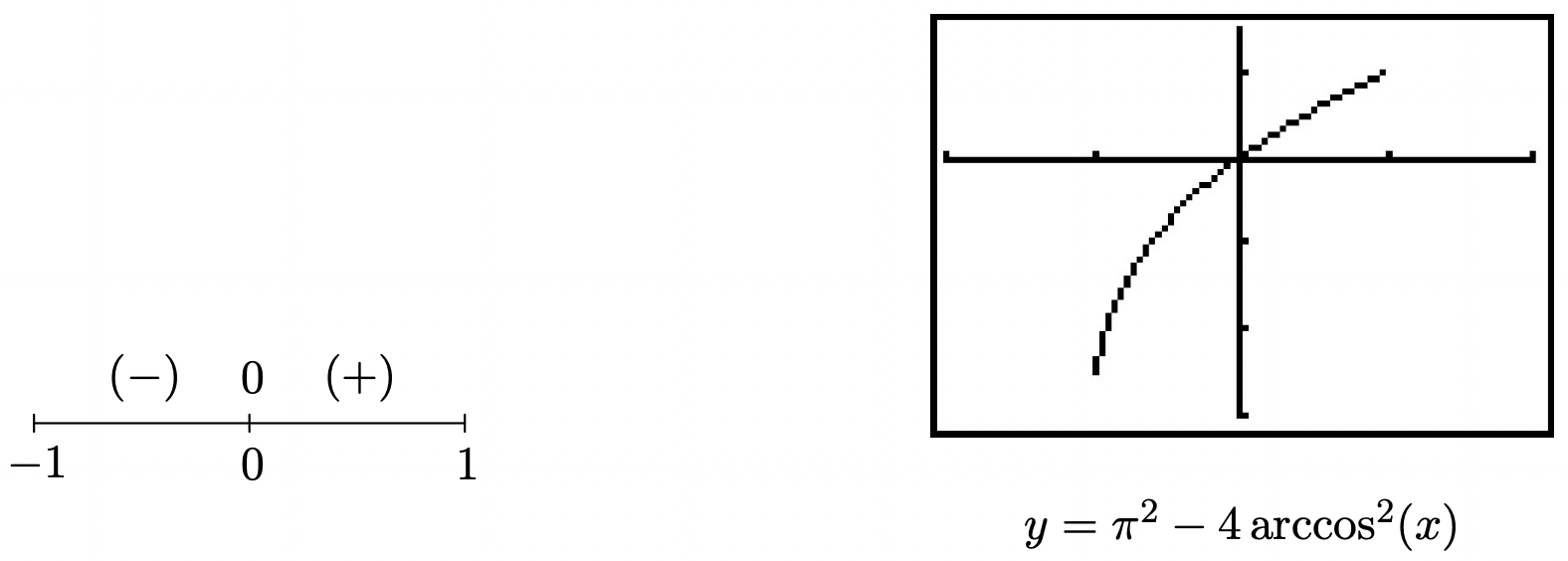
- To begin, we rewrite 4 \operatorname{arccot}(3 x)>\pi \text { as } 4 \operatorname{arccot}(3 x)-\pi>0. We let f(x)=4 \operatorname{arccot}(3 x)-\pi, and note the domain of f is all real numbers, (-\infty, \infty). To find the zeros of f, we set f(x)=4 \operatorname{arccot}(3 x)-\pi=0 and solve. We get \operatorname{arccot}(3 x)=\frac{\pi}{4}, and since \frac{\pi}{4} is in the range of arccotangent, we may apply Theorem 10.27 and solve \begin{aligned} \operatorname{arccot}(3 x) &=\frac{\pi}{4} \\ \cot (\operatorname{arccot}(3 x)) &=\cot \left(\frac{\pi}{4}\right) \\ 3 x &=1 \quad \text { Since } \cot (\operatorname{arccot}(u))=u . \\ x &=\frac{1}{3} \end{aligned}\nonumber Next, we make a sign diagram for f. Since the domain of f is all real numbers, and there is only one zero of f, x=\frac{1}{3}, we have two test intervals, \left(-\infty, \frac{1}{3}\right) and \left(\frac{1}{3}, \infty\right). Ideally, we wish to find test values x in these intervals so that \operatorname{arccot}(4 x) corresponds to one of our oft-used ‘common’ angles. After a bit of computation,18 we choose x = 0 for x<\frac{1}{3} and for x>\frac{1}{3}, we choose x=\frac{\sqrt{3}}{3}. We find f(0)=\pi>0 and f\left(\frac{\sqrt{3}}{3}\right)=-\frac{\pi}{3}<0. Since we are looking for where f(x)=4 \operatorname{arccot}(3 x)-\pi>0, we get our answer \left(-\infty, \frac{1}{3}\right). To check graphically, we use the technique in number 2c of Example 10.6.5 in Section 10.6 to graph y=4 \operatorname{arccot}(3 x) and we see it is above the horizontal line y=\pi \text { on }\left(-\infty, \frac{1}{3}\right)=(-\infty, 0 . \overline{3}).
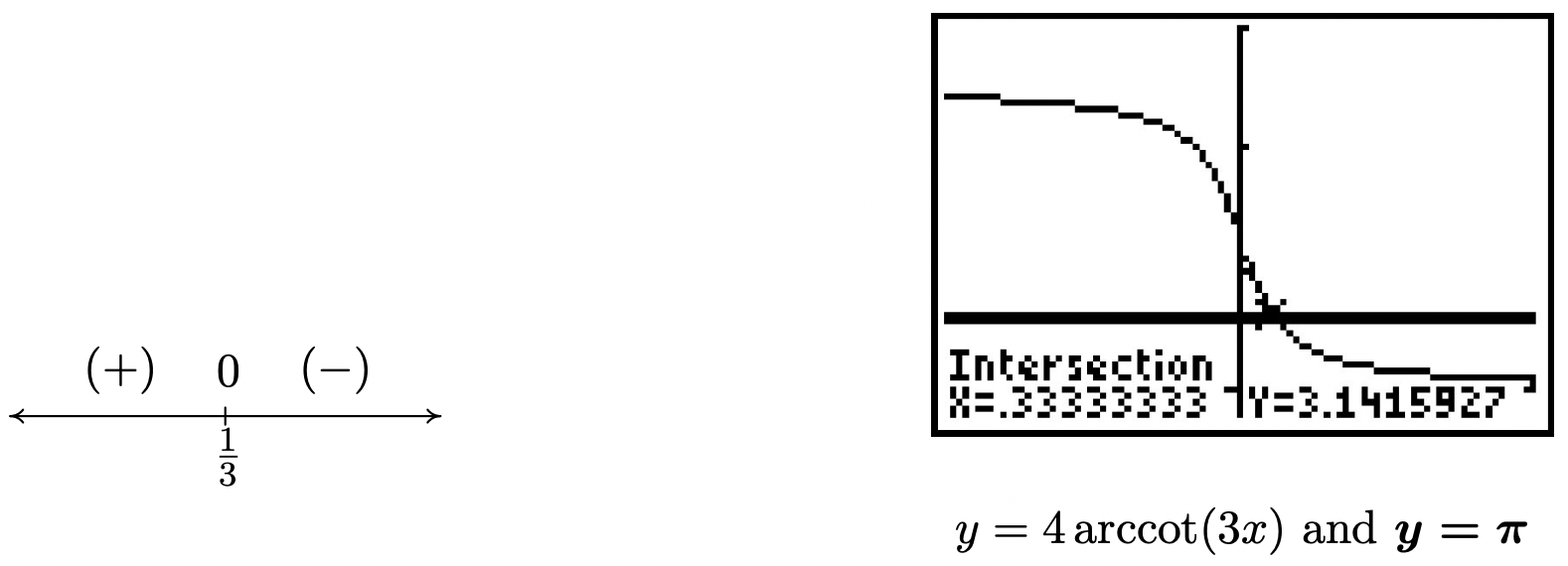
10.7.1 Exercises
In Exercises 1 - 18, find of the exact solutions of the equation and then list those solutions which are in the interval [0, 2\pi).
- \sin \left( 5x \right) = 0
- \cos \left( 3x \right) = \dfrac{1}{2}
- \sin \left( -2x \right) = \dfrac{\sqrt{3}}{2}
- \tan \left( 6x \right) = 1
- \csc \left( 4x \right) = -1
- \sec \left( 3x \right) = \sqrt{2}
- \cot \left( 2x \right) = -\dfrac{\sqrt{3}}{3}
- \cos \left( 9x \right) = 9
- \sin \left( \dfrac{x}{3} \right) = \dfrac{\sqrt{2}}{2}
- \cos \left( x + \dfrac{5\pi}{6} \right) = 0
- \sin \left( 2x - \dfrac{\pi}{3} \right) = -\dfrac{1}{2}
- 2\cos \left( x + \dfrac{7\pi}{4} \right) = \sqrt{3}
- \csc(x) = 0
- \tan \left( 2x - \pi \right) = 1
- \tan^{2} \left( x \right) = 3
- \sec^{2} \left( x \right) = \dfrac{4}{3}
- \cos^{2} \left( x \right) = \dfrac{1}{2}
- \sin^{2} \left( x \right) = \dfrac{3}{4}
In Exercises 19 - 42, solve the equation, giving the exact solutions which lie in [0, 2\pi)
- \sin \left( x \right) = \cos \left( x \right)
- \sin \left( 2x \right) = \sin \left( x \right)
- \sin \left( 2x \right) = \cos \left( x \right)
- \cos \left( 2x \right) = \sin \left( x \right)
- \cos \left( 2x \right) = \cos \left( x \right)
- \cos(2x) = 2 - 5\cos(x)
- 3\cos(2x) + \cos(x) + 2 = 0
- \cos(2x) = 5\sin(x) - 2
- 3\cos(2x) = \sin(x) + 2
- 2\sec^{2}(x) = 3 - \tan(x)
- \tan^{2}(x) = 1-\sec(x)
- \cot^{2}(x) = 3\csc(x) - 3
- \sec(x) = 2\csc(x)
- \cos(x)\csc(x)\cot(x) = 6-\cot^{2}(x)
- \sin(2x) = \tan(x)
- \cot^{4}(x) = 4\csc^{2}(x) - 7
- \cos(2x) + \csc^{2}(x) = 0
- \tan^{3} \left( x \right) = 3\tan \left( x \right)
- \tan^{2} \left( x \right) = \dfrac{3}{2} \sec \left( x \right)
- \cos^{3} \left( x \right) = -\cos \left( x \right)
- \tan (2x) - 2\cos(x) = 0
- \csc^{3}(x) + \csc^{2}(x) = 4\csc(x) + 4
- 2\tan(x) = 1 - \tan^{2}(x)
- \tan \left( x \right) = \sec \left( x \right)
In Exercises 43 - 58, solve the equation, giving the exact solutions which lie in [0, 2\pi)
- \sin(6x) \cos(x) = -\cos(6x) \sin(x)
- \sin(3x)\cos(x) = \cos(3x) \sin(x)
- \cos(2x)\cos(x) + \sin(2x)\sin(x) = 1
- \cos(5x)\cos(3x) - \sin(5x)\sin(3x) = \dfrac{\sqrt{3}}{2}
- \sin(x) + \cos(x) = 1
- \sin(x) + \sqrt{3} \cos(x) = 1
- \sqrt{2} \cos(x) - \sqrt{2} \sin(x) = 1
- \sqrt{3} \sin(2x) + \cos(2x) = 1
- \cos(2x) - \sqrt{3} \sin(2x) = \sqrt{2}
- 3\sqrt{3}\sin(3x) - 3\cos(3x) = 3\sqrt{3}
- \cos(3x) = \cos(5x)
- \cos(4x) = \cos(2x)
- \sin(5x) = \sin(3x)
- \cos(5x) = -\cos(2x)
- \sin(6x) + \sin(x) = 0
- \tan(x) = \cos(x)
In Exercises 59 - 68, solve the equation.
- \arccos (2 x)=\pi
- \pi-2 \arcsin (x)=2 \pi
- 4 \arctan (3 x-1)-\pi=0
- 6 \operatorname{arccot}(2 x)-5 \pi=0
- 4 \operatorname{arcsec}\left(\frac{x}{2}\right)=\pi
- 12 \operatorname{arccsc}\left(\frac{x}{3}\right)=2 \pi
- 9 \arcsin ^{2}(x)-\pi^{2}=0
- 9 \arccos ^{2}(x)-\pi^{2}=0
- 8 \operatorname{arccot}^{2}(x)+3 \pi^{2}=10 \pi \operatorname{arccot}(x)
- 6 \arctan (x)^{2}=\pi \arctan (x)+\pi^{2}
In Exercises 69 - 80, solve the inequality. Express the exact answer in interval notation, restricting your attention 0 \leq x \leq 2 \pi.
- \sin \left( x \right) \leq 0
- \tan \left( x \right) \geq \sqrt{3}
- \sec^{2} \left( x \right) \leq 4
- \cos^{2} \left( x \right) > \dfrac{1}{2}
- \cos \left( 2x \right) \leq 0
- \sin \left( x + \dfrac{\pi}{3} \right) > \dfrac{1}{2}
- \cot^{2} \left( x \right) \geq \dfrac{1}{3}
- 2\cos(x) \geq 1
- \sin(5x) \geq 5
- \cos(3x) \leq 1
- \sec(x) \leq \sqrt{2}
- \cot(x) \leq 4
In Exercises 81 - 86, solve the inequality. Express the exact answer in interval notation, restricting your attention to -\pi \leq x \leq \pi.
- \cos \left( x \right) > \dfrac{\sqrt{3}}{2}
- \sin(x) > \dfrac{1}{3}
- \sec \left( x \right) \leq 2
- \sin^{2} \left( x \right) < \dfrac{3}{4}
- \cot \left( x \right) \geq -1
- \cos(x) \geq \sin(x)
In Exercises 87 - 92, solve the inequality. Express the exact answer in interval notation, restricting your attention to -2 \pi \leq x \leq 2 \pi.
- \csc \left( x \right) > 1
- \cos(x) \leq \dfrac{5}{3}
- \cot(x) \geq 5
- \tan^{2} \left( x \right) \geq 1
- \sin(2x) \geq \sin(x)
- \cos(2x) \leq \sin(x)
In Exercises 93 - 92, solve the given inequality.
- \arcsin (2 x)>0
- 3 \arccos (x) \leq \pi
- 6 \operatorname{arccot}(7 x) \geq \pi
- \pi>2 \arctan (x)
- 2 \arcsin (x)^{2}>\pi \arcsin (x)
- 12 \arccos (x)^{2}+2 \pi^{2}>11 \pi \arccos (x)
In Exercises 99 - 107, express the domain of the function using the extended interval notation. (See page 756 in Section 10.3.1 for details.)
- f(x)=\frac{1}{\cos (x)-1}
- f(x)=\frac{\cos (x)}{\sin (x)+1}
- f(x)=\sqrt{\tan ^{2}(x)-1}
- f(x)=\sqrt{2-\sec (x)}
- f(x)=\csc (2 x)
- f(x)=\frac{\sin (x)}{2+\cos (x)}
- f(x)=3 \csc (x)+4 \sec (x)
- f(x)=\ln (|\cos (x)|)
- f(x)=\arcsin (\tan (x))
- With the help of your classmates, determine the number of solutions to \sin(x) = \frac{1}{2} in [0,2\pi). Then find the number of solutions to \sin(2x) = \frac{1}{2}, \sin(3x) = \frac{1}{2} and \sin(4x) = \frac{1}{2} in [0,2\pi). A pattern should emerge. Explain how this pattern would help you solve equations like \sin(11x) = \frac{1}{2}. Now consider \sin\left(\frac{x}{2}\right) = \frac{1}{2}, \sin\left(\frac{3x}{2}\right) = \frac{1}{2} and \sin\left(\frac{5x}{2}\right) = \frac{1}{2}. What do you find? Replace \dfrac{1}{2} with -1 and repeat the whole exploration.
10.7.2. Answers
- x = \dfrac{\pi k}{5}; \; x = 0, \dfrac{\pi}{5}, \dfrac{2\pi}{5}, \dfrac{3\pi}{5}, \dfrac{4\pi}{5}, \pi, \dfrac{6\pi}{5}, \dfrac{7\pi}{5}, \dfrac{8\pi}{5}, \dfrac{9\pi}{5}
- x = \dfrac{\pi}{9} + \dfrac{2\pi k}{3} or x = \dfrac{5\pi}{9} + \dfrac{2\pi k}{3}; \; x = \dfrac{\pi}{9}, \dfrac{5\pi}{9}, \dfrac{7\pi}{9}, \dfrac{11\pi}{9}, \dfrac{13\pi}{9}, \dfrac{17\pi}{9}
- x = \dfrac{2\pi}{3} + \pi k or x = \dfrac{5\pi}{6} + \pi k; \; x = \dfrac{2\pi}{3}, \dfrac{5\pi}{6}, \dfrac{5\pi}{3}, \dfrac{11\pi}{6}
- x = \dfrac{\pi}{24} + \dfrac{\pi k}{6}; \; x = \dfrac{\pi}{24}, \dfrac{5\pi}{24}, \dfrac{3\pi}{8}, \dfrac{13\pi}{24}, \dfrac{17\pi}{24}, \dfrac{7\pi}{8}, \dfrac{25\pi}{24}, \dfrac{29\pi}{24}, \dfrac{11\pi}{8}, \dfrac{37\pi}{24}, \dfrac{41\pi}{24}, \dfrac{15\pi}{8}
- x = \dfrac{3\pi}{8} + \dfrac{\pi k}{2}; \; x = \dfrac{3\pi}{8}, \dfrac{7\pi}{8}, \dfrac{11\pi}{8}, \dfrac{15\pi}{8}
- x = \dfrac{\pi}{12} + \dfrac{2\pi k}{3} or x = \dfrac{7\pi}{12} + \dfrac{2\pi k}{3}; \; x = \dfrac{\pi}{12}, \dfrac{7\pi}{12}, \dfrac{3\pi}{4}, \dfrac{5\pi}{4}, \dfrac{17\pi}{12}, \dfrac{23\pi}{12}
- x = \dfrac{\pi}{3} + \dfrac{\pi k}{2}; \; x = \dfrac{\pi}{3}, \dfrac{5\pi}{6}, \dfrac{4\pi}{3}, \dfrac{11\pi}{6}
- No solution
- x = \dfrac{3\pi}{4} + 6\pi k or x = \dfrac{9\pi}{4} + 6\pi k; \; x = \dfrac{3\pi}{4}
- x = -\dfrac{\pi}{3} + \pi k; \; x = \dfrac{2\pi}{3}, \dfrac{5\pi}{3}
- x = \dfrac{3\pi}{4} + \pi k or x = \dfrac{13\pi}{12} + \pi k; \; x = \dfrac{\pi}{12}, \dfrac{3\pi}{4}, \dfrac{13\pi}{12}, \dfrac{7\pi}{4}
- x = -\dfrac{19\pi}{12} + 2\pi k or x = \dfrac{\pi}{12} + 2\pi k; \; x = \dfrac{\pi}{12}, \dfrac{5\pi}{12}
- No solution
- x = \dfrac{5\pi}{8} + \dfrac{\pi k}{2}; \; x = \dfrac{\pi}{8}, \dfrac{5\pi}{8}, \dfrac{9\pi}{8}, \dfrac{13\pi}{8}
- x = \dfrac{\pi}{3} + \pi k or x = \dfrac{2\pi}{3} + \pi k; \; x = \dfrac{\pi}{3}, \dfrac{2\pi}{3}, \dfrac{4\pi}{3}, \dfrac{5\pi}{3}
- x = \dfrac{\pi}{6} + \pi k or x = \dfrac{5\pi}{6} + \pi k; \; x = \dfrac{\pi}{6}, \dfrac{5\pi}{6}, \dfrac{7\pi}{6}, \dfrac{11\pi}{6}
- x = \dfrac{\pi}{4} + \dfrac{\pi k}{2}; \; x = \dfrac{\pi}{4}, \dfrac{3\pi}{4}, \dfrac{5\pi}{4}, \dfrac{7\pi}{4}
- x = \dfrac{\pi}{3} + \pi k or x = \dfrac{2\pi}{3} + \pi k; \; x = \dfrac{\pi}{3}, \dfrac{2\pi}{3}, \dfrac{4\pi}{3}, \dfrac{5\pi}{3}
- x = \dfrac{\pi}{4}, \dfrac{5\pi}{4}
- x = 0, \dfrac{\pi}{3}, \pi, \dfrac{5\pi}{3}
- x = \dfrac{\pi}{6}, \dfrac{\pi}{2}, \dfrac{5\pi}{6}, \dfrac{3\pi}{2}
- x = \dfrac{\pi}{6}, \dfrac{5\pi}{6}, \dfrac{3\pi}{2}
- x = 0, \dfrac{2\pi}{3}, \dfrac{4\pi}{3}
- x=\dfrac{\pi}{3}, \dfrac{5\pi}{3}
- x = \dfrac{2\pi}{3}, \dfrac{4\pi}{3}, \arccos\left(\dfrac{1}{3}\right), 2\pi -\arccos\left(\dfrac{1}{3}\right)
- x=\dfrac{\pi}{6}, \dfrac{5\pi}{6}
- x = \dfrac{7\pi}{6}, \dfrac{11\pi}{6}, \arcsin\left(\dfrac{1}{3}\right), \pi - \arcsin\left(\dfrac{1}{3}\right)
- x=\dfrac{3\pi}{4}, \dfrac{7\pi}{4}, \arctan\left(\dfrac{1}{2}\right), \pi +\arctan\left(\dfrac{1}{2}\right)
- x=0, \dfrac{2\pi}{3}, \dfrac{4\pi}{3}
- x=\dfrac{\pi}{6}, \dfrac{5\pi}{6}, \dfrac{\pi}{2}
- x=\arctan(2), \pi + \arctan(2)
- x = \dfrac{\pi}{6}, \dfrac{7\pi}{6}, \dfrac{5\pi}{6}, \dfrac{11\pi}{6}
- x = 0, \pi, \dfrac{\pi}{4}, \dfrac{3\pi}{4}, \dfrac{5\pi}{4}, \dfrac{7\pi}{4}
- x = \dfrac{\pi}{6}, \dfrac{\pi}{4}, \dfrac{3\pi}{4}, \dfrac{5\pi}{6}, \dfrac{7\pi}{6}, \dfrac{5\pi}{4}, \dfrac{7\pi}{4}, \dfrac{11\pi}{6}
- x = \dfrac{\pi}{2}, \dfrac{3\pi}{2}
- x = 0, \dfrac{\pi}{3}, \dfrac{2\pi}{3}, \pi, \dfrac{4\pi}{3}, \dfrac{5\pi}{3}
- x = \dfrac{\pi}{3}, \dfrac{5\pi}{3}
- x = \dfrac{\pi}{2}, \dfrac{3\pi}{2}
- x = \dfrac{\pi}{6}, \dfrac{\pi}{2}, \dfrac{5\pi}{6}, \dfrac{3\pi}{2}
- x = \dfrac{\pi}{6}, \dfrac{5\pi}{6}, \dfrac{7\pi}{6}, \dfrac{3\pi}{2}, \dfrac{11\pi}{6}
- x = \dfrac{\pi}{8}, \dfrac{5\pi}{8}, \dfrac{9\pi}{8}, \dfrac{13\pi}{8}
- No solution
- x = 0, \dfrac{\pi}{7}, \dfrac{2\pi}{7}, \dfrac{3\pi}{7}, \dfrac{4\pi}{7}, \dfrac{5\pi}{7}, \dfrac{6\pi}{7}, \pi, \dfrac{8\pi}{7}, \dfrac{9\pi}{7}, \dfrac{10\pi}{7}, \dfrac{11\pi}{7}, \dfrac{12\pi}{7}, \dfrac{13\pi}{7}
- x=0, \dfrac{\pi}{2}, \pi, \dfrac{3\pi}{2}
- x = 0
- x = \dfrac{\pi}{48}, \dfrac{11\pi}{48}, \dfrac{13\pi}{48}, \dfrac{23\pi}{48}, \dfrac{25\pi}{48}, \dfrac{35\pi}{48}, \dfrac{37\pi}{48}, \dfrac{47\pi}{48}, \dfrac{49\pi}{48}, \dfrac{59\pi}{48}, \dfrac{61\pi}{48}, \dfrac{71\pi}{48}, \dfrac{73\pi}{48}, \dfrac{83\pi}{48}, \dfrac{85\pi}{48}, \dfrac{95\pi}{48}
- x = 0, \dfrac{\pi}{2}
- x = \dfrac{\pi}{2}, \dfrac{11\pi}{6}
- x = \dfrac{\pi}{12}, \dfrac{17\pi}{12}
- x= 0, \pi, \dfrac{\pi}{3}, \dfrac{4\pi}{3}
- x = \dfrac{17 \pi}{24}, \dfrac{41 \pi}{24}, \dfrac{23\pi}{24}, \dfrac{47\pi}{24}
- x = \dfrac{\pi}{6}, \dfrac{5\pi}{18}, \dfrac{5\pi}{6}, \dfrac{17\pi}{18}, \dfrac{3\pi}{2}, \dfrac{29\pi}{18}
- x = 0, \dfrac{\pi}{4}, \dfrac{\pi}{2}, \dfrac{3\pi}{4}, \pi, \dfrac{5\pi}{4}, \dfrac{3\pi}{2}, \dfrac{7\pi}{4}
- x = 0, \dfrac{\pi}{3}, \dfrac{2\pi}{3}, \pi, \dfrac{4\pi}{3}, \dfrac{5\pi}{3}
- x = 0, \dfrac{\pi}{8}, \dfrac{3\pi}{8}, \dfrac{5\pi}{8}, \dfrac{7\pi}{8}, \pi, \dfrac{9\pi}{8}, \dfrac{11\pi}{8}, \dfrac{13\pi}{8}, \dfrac{15\pi}{8}
- x = \dfrac{\pi}{7}, \dfrac{\pi}{3}, \dfrac{3\pi}{7}, \dfrac{5\pi}{7}, \pi, \dfrac{9\pi}{7}, \dfrac{11\pi}{7}, \dfrac{5\pi}{3}, \dfrac{13\pi}{7}
- x = \dfrac{2\pi}{7}, \dfrac{4\pi}{7}, \dfrac{6\pi}{7}, \dfrac{8\pi}{7}, \dfrac{10\pi}{7}, \dfrac{12\pi}{7}, \dfrac{\pi}{5}, \dfrac{3\pi}{5}, \pi, \dfrac{7\pi}{5}, \dfrac{9\pi}{5}
- x = \arcsin \left( \dfrac{-1 + \sqrt{5}}{2} \right) \approx 0.6662, \pi - \arcsin \left( \dfrac{-1 + \sqrt{5}}{2} \right) \approx 2.4754
- x=-\frac{1}{2}
- x = −1
- x=\frac{2}{3}
- x=-\frac{\sqrt{3}}{2}
- x=2 \sqrt{2}
- x = 6
- x=\pm \frac{\sqrt{3}}{2}
- x=\frac{1}{2}
- x = −1, 0
- x=-\sqrt{3}
- \left[ \pi, 2\pi \right]
- \left[ \dfrac{\pi}{3}, \dfrac{\pi}{2} \right) \cup \left[ \dfrac{4\pi}{3}, \dfrac{3\pi}{2} \right)
- \left[ 0, \dfrac{\pi}{3} \right] \cup \left[ \dfrac{2\pi}{3}, \dfrac{4\pi}{3} \right] \cup \left[ \dfrac{5\pi}{3}, 2\pi \right]
- \left[ 0, \dfrac{\pi}{4} \right) \cup \left( \dfrac{3\pi}{4}, \dfrac{5\pi}{4} \right) \cup \left( \dfrac{7\pi}{4}, 2\pi \right]
- \left[ \dfrac{\pi}{4}, \dfrac{3\pi}{4} \right] \cup \left[ \dfrac{5\pi}{4}, \dfrac{7\pi}{4} \right]
- \left[ 0, \dfrac{\pi}{2} \right) \cup \left( \dfrac{11\pi}{6}, 2\pi \right]
- \left( 0, \dfrac{\pi}{3} \right] \cup \left[ \dfrac{2\pi}{3}, \pi \right) \cup \left( \pi, \dfrac{4\pi}{3} \right] \cup \left[ \dfrac{5\pi}{3}, 2\pi \right)
- \left[0, \dfrac{\pi}{3}\right] \cup \left[\dfrac{5\pi}{3}, 2\pi\right]
- No solution
- [0, 2\pi]
- \left[0, \dfrac{\pi}{4} \right] \cup \left(\dfrac{\pi}{2}, \dfrac{3\pi}{2}\right) \cup \left[\dfrac{7\pi}{4}, 2\pi\right]
- \left[\text{arccot}(4), \pi \right) \cup \left[ \pi + \text{arccot}(4), 2\pi\right)
- \left( -\dfrac{\pi}{6}, \dfrac{\pi}{6} \right)
- \left( \arcsin\left(\dfrac{1}{3}\right), \pi - \arcsin\left(\dfrac{1}{3}\right) \right)
- \left[ -\pi, -\dfrac{\pi}{2} \right) \cup \left[ -\dfrac{\pi}{3}, \dfrac{\pi}{3} \right] \cup \left( \dfrac{\pi}{2}, \pi \right]
- \left( -\dfrac{2\pi}{3}, -\dfrac{\pi}{3} \right) \cup \left( \dfrac{\pi}{3}, \dfrac{2\pi}{3} \right)
- \left( -\pi, -\dfrac{\pi}{4} \right] \cup \left( 0, \dfrac{3\pi}{4} \right]
- \left[ -\dfrac{3\pi}{4}, \dfrac{\pi}{4} \right]
- \left( -2\pi, -\dfrac{3\pi}{2} \right) \cup \left( -\dfrac{3\pi}{2}, -\pi \right) \cup \left( 0, \dfrac{\pi}{2} \right) \cup \left( \dfrac{\pi}{2}, \pi \right)
- [-2\pi, 2\pi]
- \left(-2\pi, \text{arccot}(5) - 2\pi\right] \cup \left(-\pi, \text{arccot}(5) - \pi\right] \cup \left(0, \text{arccot}(5)\right] \cup \left(\pi, \pi + \text{arccot}(5)\right]
- \left[ -\dfrac{7\pi}{4}, -\dfrac{3\pi}{2} \right) \cup \left( -\dfrac{3\pi}{2}, -\dfrac{5\pi}{4} \right] \cup \left[ -\dfrac{3\pi}{4}, -\dfrac{\pi}{2} \right) \cup \left( -\dfrac{\pi}{2}, -\dfrac{\pi}{4} \right] \cup \left[ \dfrac{\pi}{4}, \dfrac{\pi}{2} \right) \cup \left( \dfrac{\pi}{2}, \dfrac{3\pi}{4} \right] \cup \left[ \dfrac{5\pi}{4}, \dfrac{3\pi}{2} \right) \cup \left( \dfrac{3\pi}{2}, \dfrac{7\pi}{4} \right]
- \left[ -2\pi, -\dfrac{5\pi}{3} \right] \cup \left[ -\pi, -\dfrac{\pi}{3} \right] \cup \left[ 0, \dfrac{\pi}{3} \right] \cup \left[ \pi, \dfrac{5\pi}{3} \right]
- \left[-\frac{11 \pi}{6},-\frac{7 \pi}{6}\right] \cup\left[\frac{\pi}{6}, \frac{5 \pi}{6}\right] \cup,\left\{-\frac{\pi}{2}, \frac{3 \pi}{2}\right\}
- \left(0, \frac{1}{2}\right]
- \left[\frac{1}{2}, 1\right]
- \left(-\infty, \frac{\sqrt{3}}{7}\right]
- (-\infty, \infty)
- [-1,0)
- \left[-1,-\frac{1}{2}\right) \cup\left(\frac{\sqrt{2}}{2}, 1\right]
- \bigcup_{k=-\infty}^{\infty}(2 k \pi,(2 k+2) \pi)
- \bigcup_{k=-\infty}^{\infty}\left(\frac{(4 k-1) \pi}{2}, \frac{(4 k+3) \pi}{2}\right)
- \bigcup_{k=-\infty}^{\infty}\left\{\left[\frac{(4 k+1) \pi}{4}, \frac{(2 k+1) \pi}{2}\right) \cup\left(\frac{(2 k+1) \pi}{2}, \frac{(4 k+3) \pi}{4}\right]\right\}
- \bigcup_{k=-\infty}^{\infty}\left\{\left[\frac{(6 k-1) \pi}{3}, \frac{(6 k+1) \pi}{3}\right] \cup\left(\frac{(4 k+1) \pi}{2}, \frac{(4 k+3) \pi}{2}\right)\right\}
- \bigcup_{k=-\infty}^{\infty}\left(\frac{k \pi}{2}, \frac{(k+1) \pi}{2}\right)
- (-\infty, \infty)
- \bigcup_{k=-\infty}^{\infty}\left(\frac{k \pi}{2}, \frac{(k+1) \pi}{2}\right)
- \bigcup_{k=-\infty}^{\infty}\left(\frac{(2 k-1) \pi}{2}, \frac{(2 k+1) \pi}{2}\right)
- \bigcup_{k=-\infty}^{\infty}\left[\frac{(4 k-1) \pi}{4}, \frac{(4 k+1) \pi}{4}\right]
Reference
1 See the comments at the beginning of Section 10.5 for a review of this concept.
2 Don’t forget to divide 2 \pi k by 3 as well!
3 Do you see why?
4 The reader is encouraged to see what happens if we had chosen the reciprocal identity \cot (3 x)=\frac{1}{\tan (3 x)} instead. The graph on the calculator appears identical, but what happens when you try to find the intersection points?
5 Your instructor will let you know if you should abandon the analytic route at this point and use your calculator. But seriously, what fun would that be?
6 Note that we are not counting the (2 \pi, 0) in our solution set since x=2 \pi is not in the interval [0,2 \pi). In the forthcoming solutions, remember that while x=2 \pi may be a solution to the equation, it isn’t counted among the solutions in [0,2 \pi).
7 As always, experience is the greatest teacher here!
8 As always, when in doubt, write it out!
9 We are essentially ‘undoing’ the sum / difference formula for cosine or sine, depending on which form we use, so this problem is actually closely related to the previous one!
10 See page 214, Example 3.1.5, page 321, page 399, Example 6.3.2 and Example 6.4.2 for discussion of this technique.
11 See page 321 for a discussion of the non-standard character known as the interrobang.
12 We could have chosen any value \arctan (t) where t>3.
13 . . . by adding \pi through the inequality ...
14 See page 756 for details about this notation.
15 This doesn’t necessarily mean the period of f is 2 \pi. The tangent function is comprise of \cos (x) and \sin (x), but its period is half theirs. The reader is invited to investigate the period of f.
16 Since we are checking for solutions where arcsecant is positive, we know u=2 x-1 \geq 1, and so the identity applies in both cases.
17 It’s not as bad as it looks... don’t let the \pi throw you!
18 Set 3x equal to the cotangents of the ‘common angles’ and choose accordingly.


